Raymond Sokolov's The Cook's Canon: 101 Classic Recipes Everyone Should Know
This garishly colored book was on sale at Border's Discount for just a few dollars. I thought it was interesting that someone thought there could be a "cook's canon," and was curious to see what someone with such an extensive knowledge of food would consider to be essential knowledge to the home cook. To build this canon, Sokolov looked to "foods from traditions that flowed into ours" to become a part of the malleable and growing melting pot that is the Western heritage, and chose dishes that were "delicious, famous, and influential in their countries of origination."
Sokolov's knowledge and experience built after nearly 25 years of professional food writing shines through as he includes a lot of interesting historical tidbits for every dish, but there were too many inside jokes that went unexplained, and phrases in foreign language that went uninterpreted. He drew a lot of references to what might be obscure literary references--appropriate from someone who took his doctorate in classical literature, but maybe not so appropriate when directed at a home cook who's looking for a good chocolate pudding recipe. In short, while a book-loving dork like me might appreciate Sokolov's wit and intellectual charm, too often, I found his writing style inaccessible and off-putting. My opinion is only heightened by my desire that food, even high-end, quality, well-made food, become accessible and approachable to all walks of life.
That said, a cookbook review wouldn't be much of a review unless I tested at least a couple of its recipes. I decided to try two that I felt comfortable with, that were accessible, that I might be tempted to use on a regular basis, and that I had some experience with to draw comparisons with.
Bread
I think it's pretty reasonable to include bread to a cook's canon. Every culture has a version of it, and it's certainly played a large part on America's tables. It's a part of the American dream, surrounded by white picket fences. Although I've never gotten past anything more complicated than a simple poolish, I've played around with more than enough basic bread dough and taken enough instruction from different chefs and bakers over the past few years to feel really comfortable with it.
Bread dough after mixing in with the pre-fermented dough that Sokolov starts the recipe off with
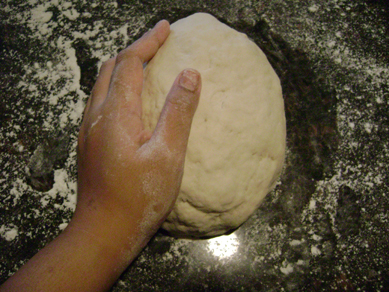
Dough doubled

As far as I'm concerned, the hardest part of any bread recipe is trying to understand the shaping directions. I followed the instructions as well as I could, and I ended up with some really ugly bread. The loaves looked like the giant rawhide logs I give my dog for Christmas. Except these smelled better. Well, they didn't smell so good when I set one of my dish towels on my hot stove top; the beginning of the baking process asked for a cup of simmering water to be poured into the oven, draping a towel over the oven door, then squirting water into the oven with a spray bottle--the next best thing if you don't have a steam-injection oven. I accidentally set a corner of my towel over the burner that I'd used to bring the water to a simmer. My smoke detector is hot-wired into my condo, so I can't just take the batteries out. A little fanning cleared it right up.
Baked bread
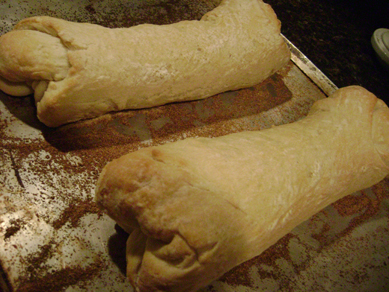
Not to be daunted by ugly bread, as I often end up with ugly food during experimenting, I tried the bread. I'll admit, I was scared. But then I tasted it. Here's the sliced bread, a bit dense, but still soft, and a nice, tasty, chewy crust. It's amazing how much flavor dough can develop just by being left to sit overnight. The tight crumb would be nice to sop up a thin sauce. I put the second loaf in the freezer for when I might need an ugly loaf of bread, then set the rest of the first loaf aside to make into croutons for later.
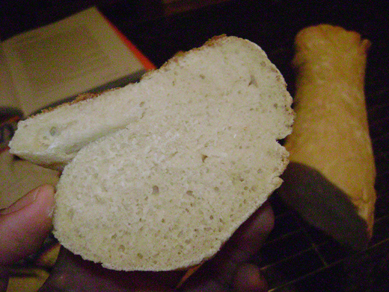
Chicken adobo: filipino chicken stew
I've had a lot of experience with chicken adobo. I grew up on it, and a few years after I left home, my mom taught me how to cook it. Since then, I've cooked it regularly, especially when hosting a Filipino dinner. The biggest difference is that I never used a recipe when I'd cook adobo--my mom taught me to just mix the sauce and taste it to see if it tasted like adobo, then add the chicken, and cook til most of the sauce was gone and the meat was falling off the bone. Following the directions took willpower as I fought off the instinct to just play it by ear. The result was wonderful ... not quite as good as mom's, but about as good as mine. ;D
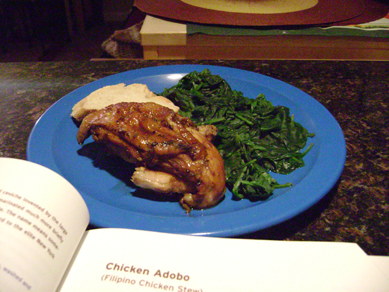
Adobo ingredients
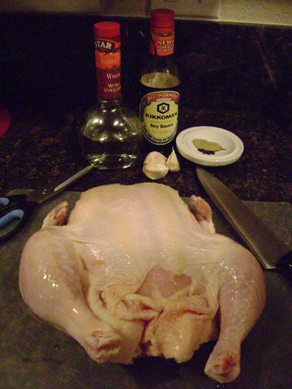
Adobo in the pot
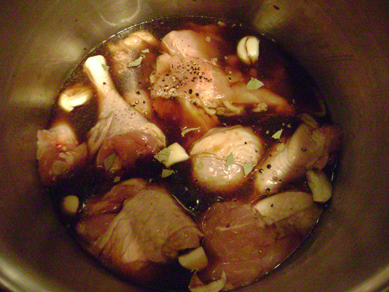
*koff koff* I think it's ready
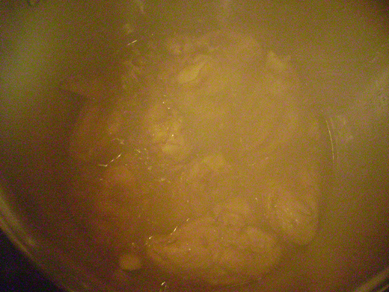
Oh yes, it's ready
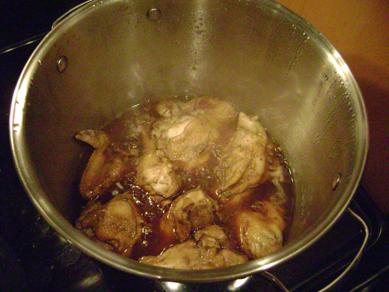
An additional step that Sokolov adds that mom and I had never done was to broil the cooked adobo to brown it, and reduce the sauce as the meat was broiling. Unfortunately, in my little condo, my smoke detector usually goes off when I broil anything. A little fanning calmed the thing down.
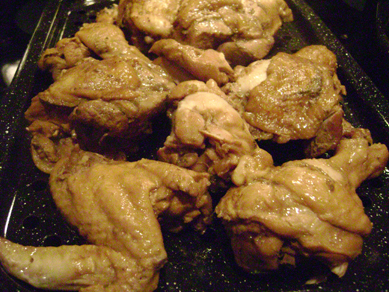
The color it brought out was very nice
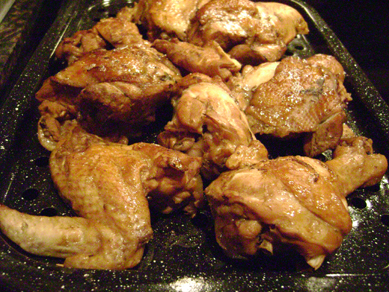
Plated adobo
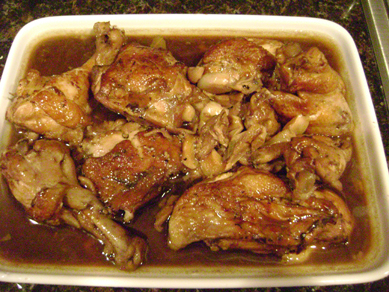
And a plate of adobo. Since I love steamed spinach with soy sauce or vinegar, I figured the adobo sauce would work really well on it. It did! And I was glad to have a nice, dense piece of bread to sop up some of the thin sauce =)
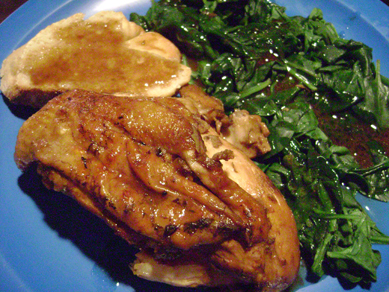
My favorite, as usual, was the dark meat. Using white wine vinegar instead of regular white vinegar made for an aromatic dish and left the chicken with an almost sweet and fruity background taste. While the breast meat wasn't dry, I'm very particular about how it's prepared, preferring it cooked as quickly as possible to retain as much moisture and flavor as possible. I portioned out the dark meat into three meals and set the breast meat aside for another project.
Going from these two dishes, I'd trust the other recipes in the book. I see a lot of them as almost a dare to complete--enticing me with their fame to try to make them in my own kitchen if I hadn't tried to already. Most use readily available ingredients, and they encompass a good variety of dishes, from apple pie to Chiles Poblanos en Nogada. There's a suspicious lack of vegetable dishes, though. It was nice to see back stories accompanying each recipe for a change instead of just page after page of recipe, as a regular cookbook would present. I just wish I could've connected more to those stories. I've already found another book that does it better, and I'm only 15 pages into it--James Beard's Beard on Food. Even though the recipes I've seen aren't as common as some of those that Sokolov delivers, Beard's short essays introducing and discussing them make the recipes memorable and too intriguing to not want to try out.
Sokolov's knowledge and experience built after nearly 25 years of professional food writing shines through as he includes a lot of interesting historical tidbits for every dish, but there were too many inside jokes that went unexplained, and phrases in foreign language that went uninterpreted. He drew a lot of references to what might be obscure literary references--appropriate from someone who took his doctorate in classical literature, but maybe not so appropriate when directed at a home cook who's looking for a good chocolate pudding recipe. In short, while a book-loving dork like me might appreciate Sokolov's wit and intellectual charm, too often, I found his writing style inaccessible and off-putting. My opinion is only heightened by my desire that food, even high-end, quality, well-made food, become accessible and approachable to all walks of life.
That said, a cookbook review wouldn't be much of a review unless I tested at least a couple of its recipes. I decided to try two that I felt comfortable with, that were accessible, that I might be tempted to use on a regular basis, and that I had some experience with to draw comparisons with.
Bread
I think it's pretty reasonable to include bread to a cook's canon. Every culture has a version of it, and it's certainly played a large part on America's tables. It's a part of the American dream, surrounded by white picket fences. Although I've never gotten past anything more complicated than a simple poolish, I've played around with more than enough basic bread dough and taken enough instruction from different chefs and bakers over the past few years to feel really comfortable with it.
Bread dough after mixing in with the pre-fermented dough that Sokolov starts the recipe off with

Dough doubled

As far as I'm concerned, the hardest part of any bread recipe is trying to understand the shaping directions. I followed the instructions as well as I could, and I ended up with some really ugly bread. The loaves looked like the giant rawhide logs I give my dog for Christmas. Except these smelled better. Well, they didn't smell so good when I set one of my dish towels on my hot stove top; the beginning of the baking process asked for a cup of simmering water to be poured into the oven, draping a towel over the oven door, then squirting water into the oven with a spray bottle--the next best thing if you don't have a steam-injection oven. I accidentally set a corner of my towel over the burner that I'd used to bring the water to a simmer. My smoke detector is hot-wired into my condo, so I can't just take the batteries out. A little fanning cleared it right up.
Baked bread

Not to be daunted by ugly bread, as I often end up with ugly food during experimenting, I tried the bread. I'll admit, I was scared. But then I tasted it. Here's the sliced bread, a bit dense, but still soft, and a nice, tasty, chewy crust. It's amazing how much flavor dough can develop just by being left to sit overnight. The tight crumb would be nice to sop up a thin sauce. I put the second loaf in the freezer for when I might need an ugly loaf of bread, then set the rest of the first loaf aside to make into croutons for later.

Chicken adobo: filipino chicken stew
I've had a lot of experience with chicken adobo. I grew up on it, and a few years after I left home, my mom taught me how to cook it. Since then, I've cooked it regularly, especially when hosting a Filipino dinner. The biggest difference is that I never used a recipe when I'd cook adobo--my mom taught me to just mix the sauce and taste it to see if it tasted like adobo, then add the chicken, and cook til most of the sauce was gone and the meat was falling off the bone. Following the directions took willpower as I fought off the instinct to just play it by ear. The result was wonderful ... not quite as good as mom's, but about as good as mine. ;D

Adobo ingredients

Adobo in the pot

*koff koff* I think it's ready

Oh yes, it's ready

An additional step that Sokolov adds that mom and I had never done was to broil the cooked adobo to brown it, and reduce the sauce as the meat was broiling. Unfortunately, in my little condo, my smoke detector usually goes off when I broil anything. A little fanning calmed the thing down.

The color it brought out was very nice

Plated adobo

And a plate of adobo. Since I love steamed spinach with soy sauce or vinegar, I figured the adobo sauce would work really well on it. It did! And I was glad to have a nice, dense piece of bread to sop up some of the thin sauce =)

My favorite, as usual, was the dark meat. Using white wine vinegar instead of regular white vinegar made for an aromatic dish and left the chicken with an almost sweet and fruity background taste. While the breast meat wasn't dry, I'm very particular about how it's prepared, preferring it cooked as quickly as possible to retain as much moisture and flavor as possible. I portioned out the dark meat into three meals and set the breast meat aside for another project.
Going from these two dishes, I'd trust the other recipes in the book. I see a lot of them as almost a dare to complete--enticing me with their fame to try to make them in my own kitchen if I hadn't tried to already. Most use readily available ingredients, and they encompass a good variety of dishes, from apple pie to Chiles Poblanos en Nogada. There's a suspicious lack of vegetable dishes, though. It was nice to see back stories accompanying each recipe for a change instead of just page after page of recipe, as a regular cookbook would present. I just wish I could've connected more to those stories. I've already found another book that does it better, and I'm only 15 pages into it--James Beard's Beard on Food. Even though the recipes I've seen aren't as common as some of those that Sokolov delivers, Beard's short essays introducing and discussing them make the recipes memorable and too intriguing to not want to try out.
Comments